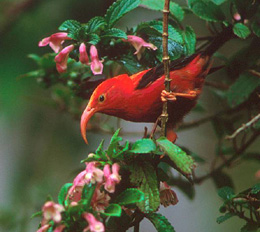Adaptive radiation
Adaptive radiation is an evolutionary process in which organisms diversify rapidly from an ancestral species into a multitude of new forms, particularly when a change in the environment makes new resources available, creates new challenges, or opens new environmental niches. This phenomenon is most evident in isolated environments, notably islands, leading to the creation of a vast diversity of life from a single ancestor. The concept of adaptive radiation was significantly advanced by the work of Charles Darwin following his observations of the unique species on the Galápagos Islands, which played a pivotal role in the development of his theory of natural selection.
Overview[edit | edit source]
Adaptive radiation involves three major aspects: the rapid proliferation of a single or a few species, the diversification of forms to exploit different ecological niches, and the impact of competition in driving speciation. This process results in the speciation and phenotypic adaptation of an array of species exhibiting different morphological and physiological traits, allowing them to exploit different resources or live in different environments.
Examples[edit | edit source]
One of the most famous examples of adaptive radiation is the diversification of the finches on the Galápagos Islands, often referred to as Darwin's finches. Each species of finch has evolved unique beak shapes and sizes to utilize different food sources, such as seeds, insects, and blood from other animals. Another well-documented case is the radiation of cichlid fish in Africa's Lake Victoria, Lake Malawi, and Lake Tanganyika. These lakes host thousands of cichlid species, many of which have arisen in the last 100,000 years. Each species has adapted to a specific niche, such as feeding on particular types of algae, fish, or invertebrates.
Mechanisms[edit | edit source]
The mechanisms driving adaptive radiation are multifaceted, involving a combination of ecological opportunity, morphological innovation, and genetic variation. Ecological opportunity occurs when new habitats are available for colonization, often after a mass extinction event or when organisms migrate to a new area. Morphological innovation, such as the development of a new physical trait, allows organisms to exploit resources in new ways. Genetic variation is crucial for providing the raw material for natural selection to act upon, leading to the evolution of new species.
Significance[edit | edit source]
Adaptive radiation is significant for several reasons. It demonstrates the power of natural selection in shaping the diversity of life, provides insights into the process of speciation, and helps explain the distribution of biodiversity across different ecosystems and geographical areas. Furthermore, studying adaptive radiation can offer valuable information on the resilience and adaptability of life in the face of environmental changes.
Challenges and Future Directions[edit | edit source]
While adaptive radiation is a well-supported theory, challenges remain in understanding the precise mechanisms and predicting when and where it will occur. Future research may focus on the genetic basis of adaptation and speciation, the role of ecological interactions in driving diversification, and the impact of climate change on adaptive radiation patterns.
Search WikiMD
Ad.Tired of being Overweight? Try W8MD's physician weight loss program.
Semaglutide (Ozempic / Wegovy and Tirzepatide (Mounjaro / Zepbound) available.
Advertise on WikiMD
|
WikiMD's Wellness Encyclopedia |
| Let Food Be Thy Medicine Medicine Thy Food - Hippocrates |
Translate this page: - East Asian
中文,
日本,
한국어,
South Asian
हिन्दी,
தமிழ்,
తెలుగు,
Urdu,
ಕನ್ನಡ,
Southeast Asian
Indonesian,
Vietnamese,
Thai,
မြန်မာဘာသာ,
বাংলা
European
español,
Deutsch,
français,
Greek,
português do Brasil,
polski,
română,
русский,
Nederlands,
norsk,
svenska,
suomi,
Italian
Middle Eastern & African
عربى,
Turkish,
Persian,
Hebrew,
Afrikaans,
isiZulu,
Kiswahili,
Other
Bulgarian,
Hungarian,
Czech,
Swedish,
മലയാളം,
मराठी,
ਪੰਜਾਬੀ,
ગુજરાતી,
Portuguese,
Ukrainian
Medical Disclaimer: WikiMD is not a substitute for professional medical advice. The information on WikiMD is provided as an information resource only, may be incorrect, outdated or misleading, and is not to be used or relied on for any diagnostic or treatment purposes. Please consult your health care provider before making any healthcare decisions or for guidance about a specific medical condition. WikiMD expressly disclaims responsibility, and shall have no liability, for any damages, loss, injury, or liability whatsoever suffered as a result of your reliance on the information contained in this site. By visiting this site you agree to the foregoing terms and conditions, which may from time to time be changed or supplemented by WikiMD. If you do not agree to the foregoing terms and conditions, you should not enter or use this site. See full disclaimer.
Credits:Most images are courtesy of Wikimedia commons, and templates, categories Wikipedia, licensed under CC BY SA or similar.
Contributors: Prab R. Tumpati, MD


